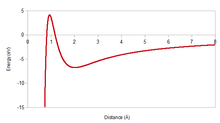Buckingham potential
In theoretical chemistry, the Buckingham potential is a formula proposed by Richard Buckingham which describes the Pauli exclusion principle and van der Waals energy for the interaction of two atoms that are not directly bonded as a function of the interatomic distance . It is a variety of interatomic potentials.
Here, , and are constants. The two terms on the right-hand side constitute a repulsion and an attraction, because their first derivatives with respect to are negative and positive, respectively.
Buckingham proposed this as a simplification of the Lennard-Jones potential, in a theoretical study of the equation of state for gaseous helium, neon and argon.[1]
As explained in Buckingham's original paper and, e.g., in section 2.2.5 of Jensen's text,[2] the repulsion is due to the interpenetration of the closed electron shells. "There is therefore some justification for choosing the repulsive part (of the potential) as an exponential function". The Buckingham potential has been used extensively in simulations of molecular dynamics.
Because the exponential term converges to a constant as →, while the term diverges, the Buckingham potential becomes attractive as becomes small. This may be problematic when dealing with a structure with very short interatomic distances, as any nuclei that cross a certain threshold will become strongly (and unphysically) bound to one another at a distance of zero.[2]
Coulomb–Buckingham potential

The Coulomb–Buckingham potential is an extension of the Buckingham potential for application to ionic systems (e.g. ceramic materials). The formula for the interaction is
where A, B, and C are suitable constants and the additional term is the electrostatic potential energy.
The above equation may be written in its alternate form as
where is the minimum energy distance, is a free dimensionless parameter and is the depth of the minimum energy.
References
- Buckingham, R. A. (1938). "The Classical Equation of State of Gaseous Helium, Neon and Argon". Proceedings of the Royal Society A. 168 (933): 264–283. Bibcode:1938RSPSA.168..264B. doi:10.1098/rspa.1938.0173. JSTOR 97239.
- F. Jensen, Introduction to Computational Chemistry, 2nd ed., Wiley, 2007,